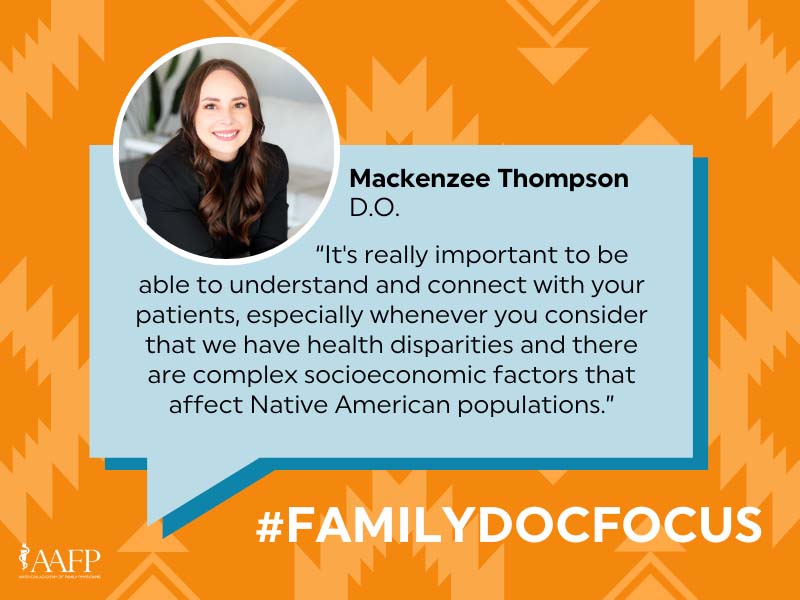Cherokee Nation Med School Nurtured Her FM Calling, Cultural Ties
Nov. 7, 2024, David Mitchell — Mackenzee Thompson, D.O., is part of the Choctaw Nation through her maternal grandmother, but she grew up in a tiny town south of the Oklahoma City metro area, roughly three hours from her family’s tribal lands in southeastern Oklahoma.

“We got separated from our traditions,” she said, “so growing up I wasn’t exposed to much Choctaw culture.”
As a child, Thompson participated in Choctaw educational programs that provided rewards for academic success. In college, she participated in the tribe’s higher education program, which provides financial assistance to tribal members pursuing degrees at accredited universities.
“I didn’t feel like I had to give back because they had helped so much with my education, but it was something that I wanted to do,” said Thompson, who graduated in May with the first class of physicians from the Oklahoma State University’s College of Osteopathic Medicine at the Cherokee Nation. “It was already on my radar to possibly practice tribally in the future when plans for the Cherokee Nation school were announced.”
American Indian and Alaska Natives account for nearly 3% of the U.S. population, but they represent just 0.3% of U.S. physicians, according to the Association of American Medical Colleges. The Cherokee Nation invested $40 million to build a medical school in Tahlequah, and the first tribally affiliated medical school opened in 2020.
Thompson was one of nine Native graduates in a class of 46. (Meanwhile, 15 Native students graduated from OSU-COM’s Tulsa campus this spring.)
Nearly 10% of Oklahoma’s population is Native American. Several tribal nations within the state have their own independent health care systems, even residency programs, such as the family medicine program Thompson is attending at the Cherokee Nation.
“It's really important to be able to understand and connect with your patients, especially whenever you consider that we have health disparities and there are complex socioeconomic factors that affect Native American populations,” she said. “It’s really important to have a physician that understands those factors and may have experienced them themselves along their journey to medicine or just in life in general. As a Native American physician taking care of Native American patients, I’m able to bring an unbiased view into their care.”
At the tribally affiliated medical school, Thompson was able to learn not only what she needed to know as a physician but also about Native American culture.
“It’s been a driving factor for me, but I didn’t even realize how important it would be to my journey until I got here and experienced the school,” she said. “I started putting the pieces together in terms of future plans. It was very cool to learn from my Choctaw colleagues, but there also are other people like me who hadn’t been connected to their heritage. Through the school, we were able to come together. We realized how many similarities we had and really leaned on each other. I could have gone to another medical school, but I don’t think I would have had as much of a community, and especially not as much of a Native American community, as I have at this school.”
Thompson didn’t have to go far to match. She’s a first-year resident at the Cherokee Nation Family Medicine Residency, which is in the same complex as the medical school. The tribe broke ground last year on a $400 million, 127-bed hospital that will replace a smaller, 40-year-old facility.
“It was super cool while I was in medical school that a lot of the family medicine residents would come help with our clinical skills labs, and the attendings from the hospital or the clinic would come over and help with our case studies,” she said. “We had a lot of involvement from the residency. By the time I was applying for residency, I already knew a lot of the attendings and residents. I kept an open mind, but I always kept coming back to this program. I’m really happy with my decision.”
She’s also happy with her decision to pursue family medicine, although it was not her original plan.
“During the first two years of med school I joined a lot of specialty clubs, nothing related to family medicine,” she said. “Then I started my third-year rotations, and I really loved ophthalmology. Specifically, I was really interested in diabetic retinopathy.”
American Indian/Alaska Native adults are 1.5 times more likely to be diagnosed with diabetes than non-Hispanic white adults. Nearly 16 percent of American Indians and Alaska Natives have diabetes, according to the Indian Health Service.
“I actually did a couple electives and was really excited about ophthalmology until I got to my tribal clinic rotation in the spring of my third year,” said Thompson, who enjoyed learning osteopathic manipulation and working with a mentor who was dual certified in family medicine and obesity medicine. “As a primary care physician, instead of thinking about, ‘How can I fix this?’ I was thinking about, ‘How can I prevent this?’”